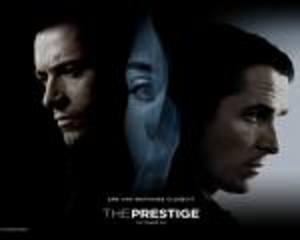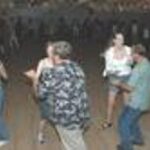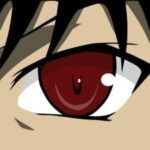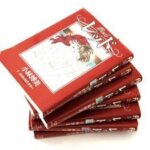Japanese culture has definitely had an influence on America. We have adapted many different things from the Japanese such as clothing style, music, and anime. What most may not notice much is the Jo-ha-kyu structure of Japanese music in American culture today. Jo-ha-kyu structure is found in many mediums from movies, books, dance, portraits, etc. One example of this structure can be found in a recent movie titled The Prestige directed by Christopher Nolan. Before I can first describe how this movie has jo-ha-kyu structure, it is probably best that I describe what Jo-ha-kyu is.
Jo-ha-kyu is a three- part rhythmic structure in which these three parts consist of. Jo represents the slow introduction of the song, which sets the stage for what is yet to come. Ha is a regular beat or pattern of notes, which stays consistent throughout the majority of the song. Kyu is the opposite of the Jo since it rushes to complete the end often ending with a type of finale. It is described in our textbook as,
An aesthetic shape is created from beginning to end of the piece by means of the coordinated percussion patterns: beginning slowly with a sense of beats but not quite regular, settling down to regular beats and gradually accelerating, gathering to a sort of climactic density, then ending with thinning texture and deceleration. (Wade 38-39).
While this method is best recognized in Japanese music, it can be noticed in many other Medias such as their paintings, their movies, and even their dance. This method had been adapted into western culture in this same way, pertaining not only to music, but to other Medias as well. The prestige is a great representation of this adaptation.
The Prestige is a movie based off the novel by British writer Christopher Priest starring Hugh Jackman and Christian Bale. It is a tale about two rivaling magicians who sacrifice many factors of their own lives for each other’s secrets. The story begins by narrating the three parts of a magic trick. These parts consist of The Pledge, which is announcing the trick and what the magician is attempting to do. The second part is the Turn, which consists of the actual movement of the trick, which gets us the last part of the trick. The last part of the trick is the Prestige, which is the most exciting part in which the trick is completed and proves whether the trick was successful or not. Since the methods of a magic trick also have three parts like Jo-ha-kyu, this is also a similarity of the two.
In Jo-ha-kyu, as stated previously, the Jo serves as a slow introduction to the song. The Prestige’s Jo, or introduction, is a slow one. It begins by a narrator asking, “Are you watching closely” (The Prestige), while the screen is slowly panning over a huge pile of top hats. There is no background music, just the quiet and this voice. This sets the stage for what is soon to come. Because this is what the narrator suggests, I know that I will really have to pay attention throughout the film so that I will not miss anything. The narrator then begins to describe the three different parts of the trick, which is the pledge, the turn, and the prestige. The setting is very calm and lures you right into the story. While the narrator is describing these parts of the trick there are two separate examples going on. One is of a man making a bird disappear for a little girl, and the second is of a man making himself disappear for a large audience. Just like the Jo of Japanese music, it introduces the story and prepares you for what is about to come. The Jo in this movie is short lived since after the narrator introduces the three parts of a magic trick, it cuts straight into the ha, which begins the story in medias res at a courthouse.
The Ha of a song serves as the body or ‘scattered part’ of a composition. This is when the song, or in this case the movie, has a regular pattern of events, slowly building up to a climax. In the Prestige Alfred Borden (Bale) is on trial for the murder of Robert Angier (Hugh Jackman). Borden is being accused for drowning Angier in a tank of water after one of his performances. Borden is later sent to his prison cell where a solicitor for a man named Lord Caldlow is offering to buy Borden’s tricks from him and is gives Borden Angier’s diary. He begins to read the story of how things have ended up the way the have. The two have been in competition with each other since the first time they met each other and compete for the title of the greater magician. This friendly competition then turns into a bitter rivalry between the two in which Borden accidentally kills Angier’s wife during a trick gone wrong and Angier shooting off three of Borden’s fingers during one of his tricks. These men’s bitter obsession consumes them until the climactic ending. This ha stays continuous since the two characters repeatedly seek vengeance upon one another while this slowly builds up the climax of the story. The story begins to speed up once this obsession becomes more dangerous. We later learn that Borden is sentenced to death by hanging for his crime and Lord Caldlow turns out to be Angier, who is still alive.
The kyu of the composition is best described as the rushing to a finish. The kyu of this movie definitely does that. Since there are so any mysteries throughout the film, they are now revealed in the end. Questions are answered and there are quick cuts to previous scenes showing things that were probably missed before. Now it is finally understood why they narrator said to pay attention in the very beginning because unless you were fully paying attention to every detail, there is a chance that you missed something. We find out that Angier had a machine to clone himself, which explains why he is still alive. Angier tries to destroy the machine since he accomplishes his goal of getting rid of Borden when a dark stranger approaches him. To Angier’s surprise Borden who too is still alive shoots him. It turns out that Borden’s secret was that he had a twin in which the two of them shared one life, which proves why he is such a great magician. Even when Angier shot off Borden’s fingers, the other lopped his off as well to better the illusion. After Angier dies, the narrator then describes three parts of a trick again and then asks if we are watching closely. If we pay attention to where Angier is at, there are tanks all around him filled with his own dead bodies. From this, we learn that Angier was killing himself every night in an attempt to frame Borden for his own murder. The narrator then states the reason why the audience of this movie is not paying attention close enough is because they really want to be fooled. The screen pans over a dead Angier in a water tank, and quickly goes off. This shows the speedy finish to this movie, which is also very well known in Jo-Ha-Kyu as well.
American culture has a lot to thank the Japanese for, this movie being no different. Without this structure, I am sure this movie would not have been as enjoyable. This structure applies to so many things that we do, we probably do not notice it. Even this paper itself has three parts, the introduction or Jo, the body ha, and a conclusion kyu. I bet if people paid more attention to this structure, that they would be able to see it in their everyday life.
Works Cited
The Prestige. Screenplay by. Jonathan Nolan and Christopher Nolan. Dir. Christopher Nolan. Prod. Aaron Ryder. DVD. Warner Bros. Pictures, 2006.
Wade, Bonnie C. Music in Japan: Experiencing Music, Expressing Culture. New York: Oxford U. Press, 2005.





